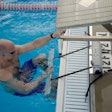
While coaches owe their players a duty to properly instruct and provide them with a safe environment for the activities to be performed, team doctors also owe athletes a duty of care — to provide proper medical attention by using all of their skills and training to keep athletes as safe as possible in the event of injury.
In examining whether a team doctor has met his or her duty of care to an athlete, the court will examine what a reasonably prudent doctor would have done under similar circumstances. If a doctor fails to meet this standard of care, the doctor is deemed to have breached their duty to the player and can be held negligent for their actions. A good illustration of the duty team doctors owe their patients and the standard of care that the court requires of them is Gleeson v. Edelson, Case No.: 20CV23083.
Strict sterilization protocols
Jake Gleeson, goalkeeper for Major League Soccer’s Portland Timbers, started experiencing pain in his legs and after seeing team physician Dr. Richard Edelson, it was determined Gleeson had bilateral stress fractures in both shins. To correct the problem, Gleeson could either rest and refrain from playing, followed by physical therapy, or have metal plates screwed onto his legs, which in theory would have allowed him to return to play sooner. Gleeson elected the surgery involving metal implants.
Once Gleeson was prepped for surgery and unconscious on the operating table, Edelson discovered that the steel shin implants and screws needed for the operation were not available in the medical center. At this point, Edelson had two options. One, he could stop the procedure, wake up Gleeson, and reschedule the surgery for another day when the properly sterilized plates and screws were on hand. Two, the option Edelson selected, was to have plates and screws brought in from a different surgery center while Gleeson remained unconscious.
The problem with the latter choice, however, is that under federal and state laws, as well as guidelines from the Centers for Disease Control and Prevention (CDC) and the U.S. Food and Drug Administration (FDA), doctors and healthcare facilities must adhere to strict sterilization protocols, ensuring that each surgical implant is properly processed, stored and verified before use. Any deviation from these protocols could be a direct breach of the standard of care, exposing the physician and the facility to litigation.
Since the implants and screws had not been previously sterilized for the operation, upon their arrival, Edelson used a steam sterilization procedure known informally as flash sterilization, or flashing. Flash sterilization is a modification of conventional sterilization in which the flashed item is placed on an open tray to allow for rapid penetration of steam. Flash sterilization is an acceptable procedure when processing cleaned patient-care items that cannot be packaged, sterilized and stored before use. Flash sterilization is also permitted when there is insufficient time to sterilize an item by the preferred package method, which was the reason Edelson claimed he used it in Gleeson’s case.
A few weeks after the surgery, Gleeson’s legs became infected. With the hope of curing the infections, Gleeson underwent more than a dozen additional surgeries. None of the procedures fixed the problem, and Gleeson continued to suffer pain, disfigurement, depression, anxiety and ultimately the loss of his playing career.
With his playing career over and still suffering from his various health issues, Gleeson sued Edelson for medical malpractice. Gleeson argued that Edelson was negligent for using an improperly sanitized orthopedic plate and screws, and — when they became infected — failing to remove them. In support of this claim, Gleeson argued that Edelson failed to adhere to the strict sterilization protocols required and that by deviating from these protocols, Edelson was in direct breach of the required standard of care.
In defense of his action, Edelson claimed that although he had never flash sterilized implants before, the use of flash sterilization on implants was permitted in cases of an emergency. Flash sterilization, Edelson argued, had been found to be perfectly safe for surgical instruments by medical experts and studies, and that tests conducted during the flash sterilization showed the implants were free of contamination. In addition, Edelson noted that after the flashing, the implants were put in sterile sealing. Therefore, Edelson argued there was no chance for the implants to become infected.
Finally, Edelson argued that no procedure can be completely free of potential infections. Edelson claimed infections occur in roughly 1% to 2% of orthopedic surgeries, and are usually due to bacteria on the patient’s own skin. Therefore, Edelson argued that infections are a risk faced by anyone who undergoes surgical procedures.
While Gleeson acknowledged that flash sterilization may be unavoidable in some cases, this was not one of them. The surgery that Edelson was performing on Gleeson was elective. Also, Gleeson noted that if flash sterilization was to be used on an implantable device, it is essential that records be carefully kept during FDA compliance documentation, the sterilization process and any resulting infection. Because of the lack of proper documentation in this case, Gleeson argued that the burden of proof shifted onto Edelson to show that he was not negligent.
Four elements of negligence
To determine whether Edelson was liable for medical malpractice in using the flashed implants and screws, the court held that — as in all negligence lawsuits — the plaintiff or injured party needed to establish four basic elements: duty of care, breach of duty, causation and damages. In examining the four elements, the court held that since Edelson was Gleeson’s team doctor and the surgeon performing the operation, he clearly owed Gleeson a duty to provide proper medical care when treating Gleeson both during the operation and after it.
In examining whether Edelson breached his duty to provide proper medical care to Gleeson, the court found that he had. It noted that as an elective surgery, there was no emergency that required the use of flashed implants. When he realized the proper equipment was not available, Edelson could have simply cancelled the procedure and rescheduled it for another day. Since there was no emergency, the jury could conclude that Edelson, by failing to adhere to the strict sterilization protocols, breached his duty to provide proper medical care. The potential for serious infections in these cases is enough that a CDC guideline states that flash sterilization is not recommended for implantable devices unless unavoidable.
Moving on to the third element, that Edelson’s breach of duty was the direct cause of Gleeson’s injuries or damages, the court agreed with Gleeson and ruled that the use of flashed implants was the direct cause of the infection. While acknowledging that there is a risk of infection anytime there is an orthopedic surgery, the jury concluded that it was the use of flashed implants that was the direct cause of the infection. In addition, the jury found that Edelson failed to remove the infected implants during the multiple surgeries he performed to correct the infection.
As for the fourth element — damages — the jury found that, because of Edelson’s negligence, Gleeson experienced several health issues, including an infection, the death of body tissue, disfigurement, depression, anxiety and the end of his professional soccer career. In calculating his damages, Gleeson claimed that based on both economic and non-economic injuries, he suffered $25 million in damages. The jury, however, slightly disagreed and reduced the damages to $20.6 million. In awarding the damages, the jury awarded Gleeson $15 million for non-economic damages such as disfigurement, pain and suffering. Interestingly, the jury only awarded $5 million for economic damages, such as medical expenses and loss of his future earnings as a professional goalkeeper.
Cost of cutting corners
While the $20.6 million awarded to Gleeson should be enough to send a clear message to team doctors and the medical community at large that it is essential for doctors to follow sterilization protocols to keep patients safe and to document their sterilization protocols to avoid lawsuits, there are lessons all sport and recreation administrators can learn from Gleeson.
First, of the $20.6 million awarded to Gleeson, the jury only awarded $5 million for economic damages, such as loss of future income. The jury, therefore, must have found that Gleeson’s performance as a professional soccer goalkeeper had already peaked by 2018. At the time of the surgery, Gleeson had already played seven seasons for the Portland Timbers. The majority of the $20.6 million awarded, some $15 million, was for non-economic damages such as physical pain, which he will live with for the rest of his life, and long-lasting emotional damage.
Second, while the case involved medical malpractice, and the lessons here are more applicable for doctors and other medical personnel, there is something that all sport and recreation administrators can take away from the case. The jury concluded that Edelson, in his rush to perform his job, was willing to cut corners. If he had stopped the procedure when he realized that he did not have the properly sterilized implants and screws, and allowed for the scheduling of a new date for surgery, while inconvenient, Edelson could have avoided a lot of trouble.
The takeaway for sport and recreation administrators, therefore, is that cutting corners is costly. Whether inspecting equipment or an entire facility, or ensuring that all staff are appropriately trained, it is essential that administrators ensure all procedures are properly followed and documented to protect themselves from legal liability.




































